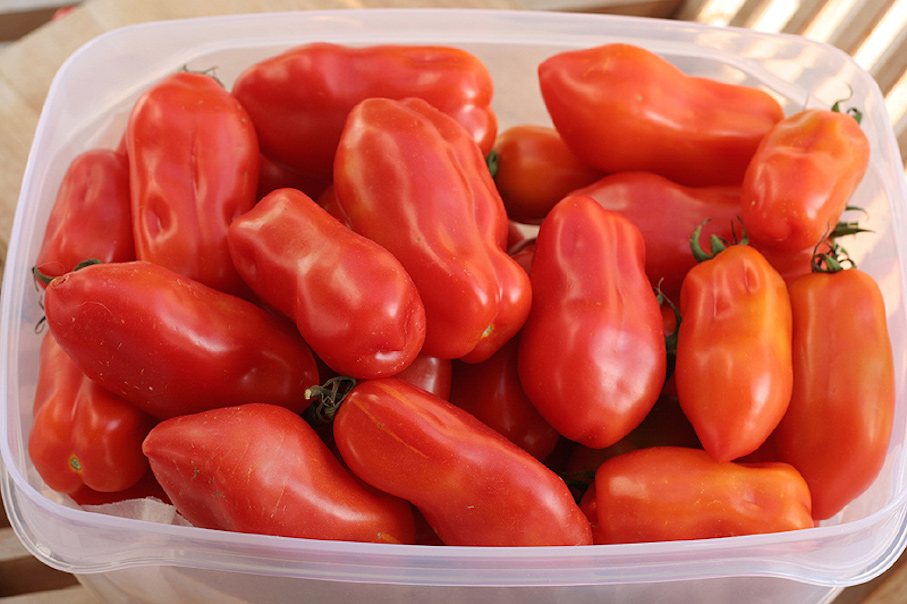When chefs throughout the world prepare authentic Italian sauce, San Marzano tomatoes are their preference. These thin, pointy, sweet plum tomatoes are essential ingredients for an authentic Pizza Napolitana, according to the Verace Pizza Napolitana Association in Naples, Italy.
San Marzano tomatoes are grown primarily in the Campania region of Italy, at the base of Mt Vesuvius, in the Agro-Nocerino area. They are cultivated in the soils of the communes of Naples, Salerno and Avellino.
These tomatoes require areas with good irrigation, and they will not thrive in hilly topography, or extreme temperatures. The soil in this area near Mt Vesuvius contains volcanic ash, phosphorous and potassium, and the climate is temperate with high humidity much of the year. Harvesting of these tomatoes begins in August and continues until the end of September or later. They are picked only after they have matured and are very ripe, and the hand picking occurs usually in the evenings when the sun is setting.
What is so different about San Marzano tomatoes? These tomatoes are plum tomatoes, but they are typically more slender and oblong, having a firm flesh. They have fewer seeds and less water content, as well as a lower amount of sugar and acid. This unique characteristic, along with their intense red color and skin, which peels easily, distinguishes these from other plum style tomatoes. During cooking, the skin practically dissolves, mixing with the pulp, and contributing to the unique flavor. San Marzano sauce is thicker, with a more concentrated tomato flavor, creating a distinctive combination of both sweet and tart flavors.
Italy’s government has granted “denomination of protected origin” (DOP) status to San Marzano tomatoes, and there are strict cultivation guidelines. Requirements include that the tomatoes be grown vertically in rows, with fruit not touching the ground, and harvested by hand. They must be cultivated in the Sarnese-Nocerino area and the yield allowed per acre is also regulated. The plants are allowed to be pruned and clipped, although forcing is not allowed.
There is a consortium of manufacturers in the region which is responsible for the safeguarding of the regulatory requirements. The label must read San Marzano Tomatoes of the Sarnese-Nocerino area D.O.P, and there must be three seals of authenticity on the label. In addition, a number must be stamped on the side panel. It is illegal in Italy for a product to claim to be San Marzano tomatoes without being in compliance with these requirements.
Like other products made in Italy, such as Parmigiano-Reggiano cheese and prosciutto di Parma, San Marzano tomatoes must have a DOP number or label, when canned, or else it is not authentic. Today many products exist with labels saying San Marzano tomatoes, but unless the DOP label is present, these products are not authentic San Marzano tomatoes, and you will notice a distinct difference in the taste. Some of the companies selling authentic DOP San Marzano canned tomato products in the US include Cento, Asti, Coluccio, Riga, Pastene, Rosa, Italbrand, La Fede, La Valle, Gia Russo, and DeLallo.
Most of these brands also sell Italian tomatoes that are not San Marzano. The true test of authenticity is the DOP label with the seals from Italy. Some individuals as well as commercial growers try to replicate the San Marzano tomatoes in other locations, but it is not the same. It is not just the seeds that might come from the San Marzano region, but also the actual cultivation process in the soil from that area, that combines to make the San Marzano tomato so special. This is why it is not possible to reproduce the flavor by buying San Marzano seeds from Italy and planting them at home in the USA or elsewhere. Believe me I’ve tried.
So when you got to Italy, and Napoli to be sure, when you order a Margherita pizza you can be assured that it is the real deal. Enjoy and Buon appetito!






























